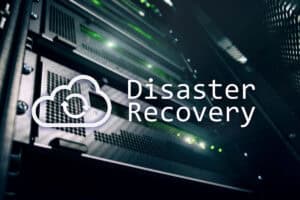The Disaster Recovery Guide for Business Continuity in Indianapolis IN

IT disaster recovery is essential for tech management for our local businesses. The ability to quickly bounce back from disruptions can mean the difference between continuing business continuity in Indianapolis IN and having to shut down.
Why IT Disaster Recovery Matters
Disaster recovery is important for several reasons:
- Protecting Critical Data: It ensures that valuable information is backed up and can be restored in case of an emergency.
- Ensuring Operational Continuity: With a solid recovery plan in place, businesses can continue their operations even after a disaster.
- Mitigating Financial Losses: By minimizing downtime and getting back to business quickly, companies can reduce potential financial losses.
Without a strong recovery plan, they may face additional risks related to Indianapolis disaster recovery preparedness and readiness.
- Potential downtime that affects productivity and revenue
- Loss of customer trust due to service interruptions
- Damage to reputation that can take years to rebuild
A well-defined disaster recovery plan serves as a lifeline, enabling local businesses to navigate crises effectively. This proactive approach not only protects important assets but also builds resilience against future threats.
Prioritizing IT disaster recovery is no longer optional; it’s a crucial strategy for ensuring stability and sustainability in an unpredictable environment.
Understanding Disaster Recovery Plans
Disaster recovery (DR) refers to the strategies and processes that ensure the restoration of critical systems and data following an unexpected disruption. A well-structured IT disaster recovery plan is vital for minimizing downtime and preventing data loss. Key components of an effective plan include:
- Risk Assessment: Identifying potential threats such as cyberattacks, natural disasters, and hardware failures.
- Business Impact Analysis (BIA): Evaluating how disruptions can affect operations, allowing prioritization of recovery efforts.
- Recovery Time Objectives (RTO): Setting clear targets for how quickly systems should be restored.
- Recovery Point Objectives (RPO): Determining the maximum acceptable amount of data loss measured in time.
The integration of cyber resilience into these plans enhances data protection. Cyber resilience goes beyond traditional security measures by focusing on a proactive approach to safeguard against various threats. This includes:
- Regular Data Backups: Ensuring that data is stored securely off-site or in the cloud.
- Endpoint Protection: Utilizing software solutions that protect devices from cyber threats while maintaining functionality.
- Continuous Monitoring: Implementing systems to detect vulnerabilities and unauthorized access attempts.
By prioritizing these elements, local businesses can create robust IT disaster recovery plans. Such preparedness not only fosters trust among clients and stakeholders but also ensures operational continuity.
Common Threats Faced by Local Businesses
Local businesses encounter various threats that can severely impact operations. Understanding these risks is crucial for developing effective disaster recovery plans.
1. Cyberattacks
These are among the most pressing threats. Small businesses often lack robust cybersecurity measures, making them attractive targets for hackers. A successful cyberattack can lead to significant data breaches, financial losses, and reputational damage. The fallout from such incidents can cripple operations and erode customer trust.
2. Natural Disasters
Events like floods, hurricanes, earthquakes, and wildfires can disrupt business continuity. Local businesses may face physical damage to their facilities, loss of inventory, and interruptions in service delivery. The unpredictability of these disasters underscores the need for comprehensive preparedness strategies.
3. Hardware Failures
Technical malfunctions can occur unexpectedly, affecting critical IT infrastructure. Hardware failures may result in data loss or extended downtime. Regular maintenance and timely upgrades of equipment can mitigate this risk.
Addressing these threats requires a proactive approach that prioritizes resilience through effective planning and the implementation of technology solutions.
Steps to Develop a Comprehensive Disaster Recovery Plan
Creating an effective disaster recovery plan is essential for safeguarding your business against disruptions. Follow these critical steps:
- Business Impact Analysis: Conduct a thorough BIA to identify potential impacts of various disruptions on your organization. This analysis helps you understand which operations are crucial for maintaining business continuity.
- Identifying Essential Operations: Assess and prioritize critical operations that must be restored promptly after a disaster. Recognize dependencies between systems, processes, and personnel involved in these operations.
- Risk Assessment: Evaluate the risks that could potentially disrupt your business. This includes identifying vulnerabilities associated with cyber threats, natural disasters, and hardware malfunctions.
- Forming a Response Team: Assemble a dedicated response team responsible for executing the disaster recovery plan. Assign clear roles and responsibilities to ensure swift action during emergencies.
- Setting Recovery Time Objectives and Recovery Point Objectives : Define your RTO, which indicates how quickly you need to restore critical functions after a disruption, and your RPO, representing the maximum acceptable amount of data loss measured in time. These metrics guide recovery priorities.
- Documentation and Communication Plan: Document each aspect of your disaster recovery plan clearly. Establish a communication strategy to keep all stakeholders informed during and after a crisis.
Regularly updating and testing your disaster recovery plan enhances its effectiveness, ensuring your business can respond efficiently when faced with unexpected challenges.
Leveraging Technology for Enhanced Disaster Recovery
Technology is crucial in improving disaster recovery efforts. Here are some ways technology can help:
Using Virtualization Technology
Virtualization technology can significantly speed up recovery times. This approach allows businesses to create virtual replicas of their IT environments, enabling quick restoration of services following a disruption. Key benefits include:
- Rapid Deployment: Virtual machines can be spun up in minutes, reducing downtime.
- Cost Efficiency: Lower hardware costs as multiple virtual servers can run on a single physical machine.
- Flexibility: Easily scalable to meet changing business needs.
Embracing Disaster Recovery as a Service
Another game-changer for local businesses is Disaster Recovery as a Service (DRaaS). This cloud-based solution offers numerous advantages:
- Off-Site Backup: Critical data is stored remotely, safeguarding against local disasters.
- Automatic Failover: In case of an outage, systems can automatically switch to backup servers, ensuring continuous operation.
- Reduced Complexity: DRaaS providers manage infrastructure and recovery processes, allowing businesses to focus on core operations.
Implementing Automation in Recovery Processes
Leveraging automation in recovery processes further enhances efficiency. Automated recovery tools help streamline tasks such as:
- Data Replication: Continuous real-time copying of critical data ensures minimal data loss.
- Testing Protocols: Regular automated testing verifies the effectiveness of disaster plans without manual intervention.
- Incident Response: Automated alerts and actions enable quicker responses to issues as they arise.
Financial and Compliance Considerations in Disaster Recovery
IT disasters can have a huge financial impact. When systems go down, businesses often lose money, customers may lose trust, and there could be legal consequences. Here are the main things to consider:
Financial Factors
- Revenue Loss: Every hour that systems are down can lead to significant financial losses, especially for small businesses that rely heavily on daily transactions.
- Data Loss Costs: If data is compromised, it can result in expensive recovery efforts and potential costs associated with compensating customers.
In addition to the financial impact, it’s also important to follow regulations. Failing to comply with regulations can result in severe penalties and harm a business’s reputation. Here are two important aspects to keep in mind:
Important Compliance Aspects
- Regulatory Standards: Many industries have specific rules about how data must be handled and protected. If these standards are not met during a disaster, fines may be imposed.
- Documentation Requirements: Keeping accurate records of recovery efforts is essential for compliance audits and proving that regulatory frameworks are being followed.
By understanding these financial and compliance factors, local businesses can better prepare their disaster recovery plans. This proactive approach not only protects valuable assets but also strengthens the ability to bounce back from future disruptions.
Supporting Employees During Disasters
Supporting employees during disasters is essential for maintaining morale and productivity. Implementing effective strategies can significantly aid recovery efforts. Consider the following approaches:
- Open Communication: Keep lines of communication clear. Share updates, resources, and recovery plans to ensure employees feel informed and involved.
- Mental Health Resources Post-Disaster: Provide access to mental health resources. This may include counseling services, stress management workshops, or wellness programs to address emotional health after a traumatic event.
- Flexible Work Arrangements: Allow for flexible hours or remote work options to accommodate individual needs during recovery.
Employee Assistance Programs (EAPs) play a vital role in this support structure. These programs offer:
- Confidential Counseling: EAPs provide professional assistance for employees facing personal or work-related challenges. This is especially critical in the aftermath of a disaster.
- Crisis Management Support: EAPs can guide companies in managing crises effectively, ensuring that employees have the necessary tools and resources to cope.
Creating a supportive environment facilitates resilience and fosters loyalty among employees. Prioritizing their well-being contributes to the overall strength of the organization during challenging times.
Promoting Long-Term Resilience through Planning and Technology Adoption
Building long-term resilience requires a proactive approach that combines strategic planning with technology adoption. Local businesses can strengthen their defenses against future disruptions by focusing on the following key areas:
1. Strategic Planning
- Conduct regular risk assessments to identify vulnerabilities.
- Develop comprehensive disaster recovery plans that outline recovery strategies, roles, and responsibilities.
- Incorporate lessons learned from past incidents into future planning efforts.
2. Technology Adoption
- Leverage cloud solutions for off-site data storage and backup. This ensures critical data remains accessible even during local disruptions.
- Implement virtualization technologies to replicate IT environments, allowing for faster recovery times in case of an incident.
- Utilize automation tools to streamline recovery processes, reducing downtime and minimizing manual errors.
Investing in these areas not only enhances operational continuity but also fosters a culture of preparedness within the organization. Employees become more engaged when they understand their roles in disaster recovery, creating a resilient workforce ready to tackle challenges head-on.
Establishing partnerships with technology providers can offer insights into emerging solutions that further enhance resilience. Staying informed about advancements in cybersecurity and disaster recovery technologies positions businesses to adapt quickly to evolving threats.
Integrating these strategies into everyday operations lays a strong foundation for long-term resilience, enabling local businesses to thrive despite uncertainties.
Implementing Your Business Continuity Plan for Long-Term Success
Disaster recovery is crucial for local businesses. Having a solid disaster recovery plan in place ensures that operations can continue even when unexpected disruptions occur, strengthening measures related to Indianapolis cybersecurity.
Here are the key points to remember:
- Protecting your data: It’s vital to safeguard your critical data.
- Reducing downtime: Quick recovery times can help prevent revenue loss and maintain customer trust.
- Staying compliant: Meeting legal requirements protects your business from potential penalties.
Start taking proactive steps today to create a strong disaster recovery plan. Identify your current weaknesses, set clear recovery goals, and use technology to improve your strategy. Don’t wait any longer; your business’s ability to bounce back may rely on it.
Frequently Asked Questions About Managed IT
What is IT disaster recovery and why is it important for small businesses?
IT disaster recovery refers to the strategies and processes that organizations implement to protect and restore their IT infrastructure after a disruptive event. For small businesses, having a well-defined disaster recovery plan is crucial as it ensures business continuity, minimizes downtime, and mitigates the impact of disruptions such as cyberattacks or natural disasters.
What are the essential elements of an effective IT disaster recovery plan?
An effective IT disaster recovery plan should include a business impact analysis (BIA), identification of critical operations, risk assessment, formation of a response team, and clear definitions of Recovery Time Objectives (RTO) and Recovery Point Objectives (RPO). These elements help in systematically addressing potential threats and ensuring swift recovery.
What common threats do local businesses face that necessitate a disaster recovery plan?
Local businesses commonly face threats such as cyberattacks, natural disasters like floods or earthquakes, and hardware failures. Each of these disruptions can lead to significant data loss or operational downtime, making it essential for businesses to have a comprehensive disaster recovery strategy in place.
How can technology enhance disaster recovery efforts for local businesses?
Technology plays a vital role in enhancing disaster recovery efforts. Virtualization technology can significantly speed up recovery times by allowing businesses to quickly restore systems. Disaster Recovery as a Service (DRaaS) provides local businesses with scalable solutions while automation improves the efficiency of the recovery process.
What financial impacts should local businesses consider when developing a disaster recovery plan?
Local businesses must consider the financial implications of downtime and data loss when developing their disaster recovery plans. Prolonged outages can lead to lost revenue, decreased customer trust, and increased costs associated with restoring operations. Compliance with regulatory requirements is essential to avoid penalties during such events.
How can businesses support employees during and after a disaster?
Supporting employees during disasters involves providing mental health resources and establishing Employee Assistance Programs (EAPs). These programs offer counseling and support services that help staff cope with stress and recover from the emotional impacts of disruptions, ensuring they feel supported throughout the process.
About the Author
Author’s recent posts
Download the
Business Owner’s Cybersecurity Blueprint


